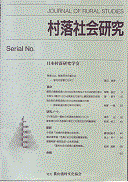4 巻, 1 号
選択された号の論文の8件中1~8を表示しています
- |<
- <
- 1
- >
- >|
論文
-
1997 年 4 巻 1 号 p. 1-8
発行日: 1997年
公開日: 2013/04/12
PDF形式でダウンロード (7054K) -
1997 年 4 巻 1 号 p. 9-20
発行日: 1997年
公開日: 2013/04/12
PDF形式でダウンロード (9899K)
研究ノート
-
1997 年 4 巻 1 号 p. 21-32
発行日: 1997年
公開日: 2013/04/12
PDF形式でダウンロード (9800K) -
1997 年 4 巻 1 号 p. 33-44
発行日: 1997年
公開日: 2013/04/12
PDF形式でダウンロード (9013K) -
1997 年 4 巻 1 号 p. 45-56
発行日: 1997年
公開日: 2013/04/12
PDF形式でダウンロード (9824K)
書評
-
1997 年 4 巻 1 号 p. 57-58
発行日: 1997年
公開日: 2013/04/12
PDF形式でダウンロード (1839K) -
1997 年 4 巻 1 号 p. 59-60
発行日: 1997年
公開日: 2013/04/12
PDF形式でダウンロード (1831K) -
1997 年 4 巻 1 号 p. 61-62
発行日: 1997年
公開日: 2013/04/12
PDF形式でダウンロード (1601K)
- |<
- <
- 1
- >
- >|
